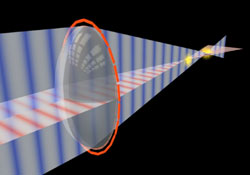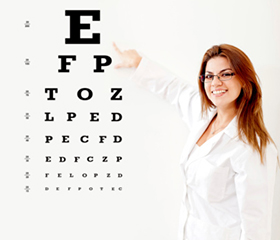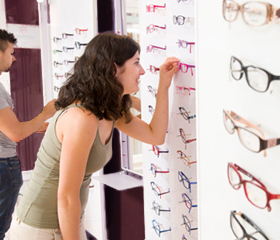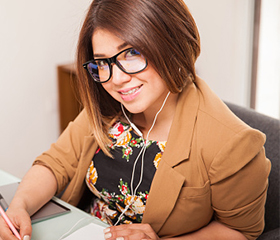Emmetropia
When rays are focused correctly on the retina of a relaxed eye, the eye is said to be emmetropic. Emmetropia is the medical term for 20/20 vision, vision that needs no corrective lenses, contact lenses, or reading glasses. It occurs because the optical power of the eye can perfectly focus an image to the retina, giving it “perfect” vision.
The opposite of emmetropia is ametropia. With ametropia, the focal point of the eye is some distance in front of or behind the retina. The following vision conditions are types of ametropia.
Hyperopia (farsightedness)
 Hyperopia is more commonly known as farsightedness. As the name suggests, people with farsightedness are able to focus on objects that are further away, but have difficulty focusing on objects which are very close. This is because the eyeball is shorter than normal, which prevents the crystalline lens in the eye from focusing correctly on the retina. About a fourth of the population is farsighted. Hyperopia can lead to chronic glaucoma, a more serious condition, later in life.
Hyperopia is more commonly known as farsightedness. As the name suggests, people with farsightedness are able to focus on objects that are further away, but have difficulty focusing on objects which are very close. This is because the eyeball is shorter than normal, which prevents the crystalline lens in the eye from focusing correctly on the retina. About a fourth of the population is farsighted. Hyperopia can lead to chronic glaucoma, a more serious condition, later in life.
A family history of hyperopia is a risk factor for developing hyperopia. Babies are often born with hyperopia but they can usually outgrow the condition as their eyes develop into the correct shape.
Hyperopia can be corrected with eyeglasses or contact lenses. There are also new surgical procedures that can correct hyperopia.
Myopia (nearsightedness)
 Myopia is the medical term for what most people call nearsightedness. It is a condition in which a person can see objects clearly only when they are close; when objects are farther away it is difficult to focus on them. Myopia usually develops in early childhood, although it sometimes develops in early adulthood. In rare cases, myopia can lead to more serious conditions such as retinal detachment.
Myopia is the medical term for what most people call nearsightedness. It is a condition in which a person can see objects clearly only when they are close; when objects are farther away it is difficult to focus on them. Myopia usually develops in early childhood, although it sometimes develops in early adulthood. In rare cases, myopia can lead to more serious conditions such as retinal detachment.
Myopia is considered a genetic disorder. If your parents are nearsighted, you are at greater risk of also being nearsighted. Another risk factor is “near work” – work involving fine detail or focusing on close objects.
Myopia can be accommodated and sometimes corrected with eyeglasses or contact lenses. Sometimes myopia continues to gradually worsen throughout life, a condition known as myopic creep. Myopia can also be corrected by LASIK surgery.
Amblyopia (lazy eye)
 Amblyopia, commonly called lazy eye, occurs when one eye develops differently than the other eye does, causing one eye to be weaker than the other. Sometimes a difference in focusing ability causes one eye to be used more often. Other times, the eyes are misaligned, causing one eye to “shut off” to avoid double vision. Regardless of the cause, the result is a weakened, or amblyopic, eye.
Amblyopia, commonly called lazy eye, occurs when one eye develops differently than the other eye does, causing one eye to be weaker than the other. Sometimes a difference in focusing ability causes one eye to be used more often. Other times, the eyes are misaligned, causing one eye to “shut off” to avoid double vision. Regardless of the cause, the result is a weakened, or amblyopic, eye.
Symptoms
It’s hard to spot amblyopia. Sometimes a child will noticeably favor one eye over the other. Another possible symptom is the child frequently bumping into things on one side. The best way to tell if your child has lazy eye is through a complete exam at about six months and three years. Early diagnosis can prevent amblyopia from leading to more serious problems, such as loss of the ability to see three dimensions or functional blindness in the amblyopic eye.
Treatment
Most of the time amblyopia cannot be entirely corrected. The amblyopic eye will always be a bit weaker than the other. However, with treatment, vision in the amblyopic eye can be improved to some extent. Treatment involves encouraging the weak eye to develop. This is done using eye patches, vision therapy, glasses, or a combination of the three. The strong eye may be patched to encourage the weak eye to develop. Vision therapy can help to correct improper use of the eyes. If a focusing error is at the root of the problem, then glasses may reduce the error. Most of the time the amblyopic eye will always require glasses.
Presbyopia
 As a people get older, usually when they hit their mid to late 40s, a condition called presbyopia can set in. Presbyopia is the inability to focus on objects near the eye. One usually notices that it is harder to read or use the computer. Bifocals or reading glasses are a way to remedy this condition.
As a people get older, usually when they hit their mid to late 40s, a condition called presbyopia can set in. Presbyopia is the inability to focus on objects near the eye. One usually notices that it is harder to read or use the computer. Bifocals or reading glasses are a way to remedy this condition.
Presbyopia is a natural consequence of the aging process. There is no cure, though researchers are constantly looking for one. Even if a someone has never had vision problems before, he can still develop presbyopia. It may seem to occur suddenly, but it actually occurs over a long period of time. Symptoms include having to hold things at arm’s length to see them clearly, eye strain, fatigue, and headaches from near work.
Astigmatism
 Sometimes the cornea is irregularly shaped, causing the eye to focus an object on two different areas of the retina. This is known as astigmatism. For the cornea to bend light correctly, it should be dome-shaped, like a basketball. Astigmatic corneas are shaped more like a football. This causes a distorted view when looking at objects which are close-up and far away.
Sometimes the cornea is irregularly shaped, causing the eye to focus an object on two different areas of the retina. This is known as astigmatism. For the cornea to bend light correctly, it should be dome-shaped, like a basketball. Astigmatic corneas are shaped more like a football. This causes a distorted view when looking at objects which are close-up and far away.
The cause of astigmatism is unknown. Astigmatism is often associated with myopia or hyperopia, and it usually is present from birth. It may be hereditary, or it may be caused by factors such as pressure on the cornea, incorrect posture, or increased use of the eyes for “near work.”
Mild astigmatism usually does not need to be corrected. Eyeglasses, contact lenses, or refractive surgery can correct moderate to high degrees of astigmatism.
Computer Vision Syndrome
Computer vision syndrome (CVS) affects three out of four computer users. It is a series of symptoms related to extended periods of computer usage. Though it is no cause for panic, measures can be taken to relieve symptoms of CVS.
Symptoms
CVS can appear as a variety of symptoms. Headaches, eye strain, neck and back aches, sensitivity to light, blurred vision, double vision, and dry or irritated eyes are all possible problems related to CVS.
Risk Factors
Any computer user can develop CVS. Your vision, your computer, and the environment where you use your computer are all factors which can lead to CVS.






